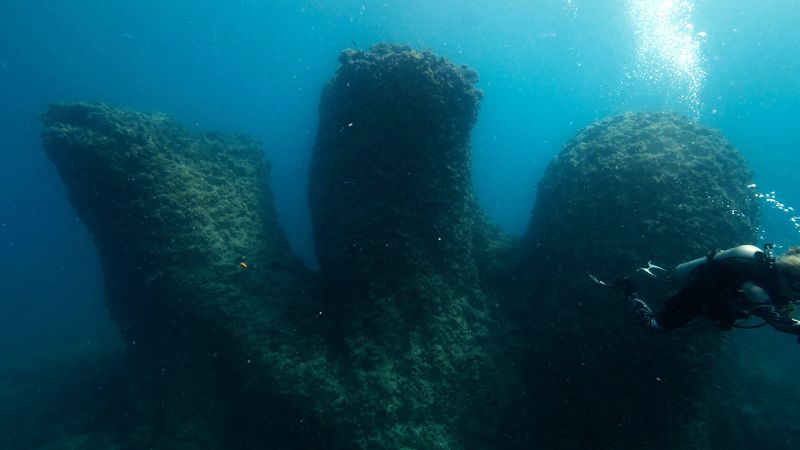
The discovery of a sunken port off the coast of Egypt may offer a puzzle piece in the longstanding search for Cleopatra’s lost tomb and glimpses into the country’s ancient maritime activity, according to researchers.
A team of underwater archaeologists, including National Geographic Explorer Kathleen Martínez and National Geographic Explorer-at-Large Bob Ballard, uncovered rows of towering structures that may have been columns, reaching over 20 feet (6 meters) high, within the Mediterranean Sea. The researchers also found evidence of polished stone floors, cemented blocks, ship anchors and tall storage jars called amphorae — all dated to the time of Cleopatra.
The team found the port after tracing a previously unearthed tunnel spanning 4,281 feet (1,305 meters) that appeared to link the site of the ancient temple of Taposiris Magna, about 30 miles (48 kilometers) west of Alexandria, to the sea.
Martínez believes Taposiris Magna is a key location in relation to Cleopatra’s burial, although many archaeologists disagree with her hypothesis.
The findings were announced on September 18 by the Egyptian Ministry of Tourism and Antiquities, published by National Geographic and aired in its documentary called “Cleopatra’s Final Secret,” now streaming on Disney+ and Hulu.
“I’ve been doing this for 50 years. I’ve been underwater. I’ve never seen anything like this. This clearly looks like it’s man-made,” said Ballard of the underwater structures in the documentary. The renowned oceanographer, a senior scientist emeritus in applied ocean physics and engineering at the Woods Hole Oceanographic Institution in Massachusetts, found the wreck of the RMS Titanic in 1985.
As a new three-month excavation begins at the temple and underwater site, Martínez, a criminal lawyer from the Dominican Republic who has turned to diplomacy and archaeology, believes the find is a promising next step in her 20-year search for the tomb of Queen Cleopatra VII.
“The discovery of the tomb of Cleopatra will be one of the biggest discoveries of the century,” she told CNN. “Since the ancient Egyptians speak to us through their tombs, I believe that she should have all this important information that she wanted us to know about her, about her time, about the way she thinks.”
The mysteries of Cleopatra’s death
Despite her short life of just 39 years, Cleopatra made an impact on the ancient world as one of a handful of female rulers and the last pharaoh of Egypt.
Cleopatra was born in Alexandria in 69 BC, crowned queen at the age of 18 and died in 30 BC after being defeated by Octavian, also known as Emperor Augustus and the founder of the Roman Empire, during the Battle of Actium in 31 BC.
As part of their victory, the Romans destroyed images of Cleopatra so that she would be forgotten, and only seven statues survive that appear to depict the queen, Martínez said.
“Cleopatra is a mystery and she also became a myth,” Martínez said. “There’s so many questions raised about her, even how she looked like. So the discovery of her tomb, if it’s intact, will answer all those questions.”
Rather than allowing herself to be captured by the Romans, legend has it that Cleopatra let a poisonous asp bite her in Alexandria, according to the documentary. But the exact circumstances of her death remain unknown, with some researchers suggesting she died by ingesting poison.
“I believe she would have done anything to stop her body being in the hands of the Romans,” Martínez said in the documentary.
Martínez’s hypothesis is that after death, Cleopatra’s body was brought to Taposiris Magna, transported through the tunnel to the offshore port and laid to rest in a secret location.
In life, Cleopatra was closely associated with the goddess Isis, given that ancient Egyptians considered royal figures to be extensions of deities. Martínez looked at all of the temples near Alexandria, where Cleopatra reportedly died, ruling them out as her final resting place if they were small or not a temple of Isis.
Martínez zeroed in on the ruins of the large temple of Taposiris Magna, located in what’s now the town of Borg El Arab, despite the fact that there was no information about which deity the temple was for or who built it.
After being granted a license to excavate at the temple in 2004, Martínez and her team uncovered a piece of blue glass in 2005. The glass, etched with descriptions in Greek and hieroglyphics, was a foundation plate that said the temple was dedicated to the goddess Isis.
Weeks later, the expedition team also found hundreds of bronze coins bearing the face and name of Cleopatra at the site. Since then, Martínez and her team have uncovered a multitude of artifacts, including the long tunnel located 43 feet (13 meters) beneath Taposiris Magna discovered in 2022. When the team realized the tunnel appeared to lead right to the sea, Martínez reached out to Ballard to see what the tunnel might be pointing to underwater.
During archaeological dives, the team found what appeared to be a sunken inland harbor, now covered by coral. Mapping shows that the ancient coastline is located about 2.4 miles (4 kilometers) from the current coastline, the ministry shared in a statement.
Dr. Mohamed Ismail Khaled, Secretary-General of the Supreme Council of Antiquities, said the discovery of the sunken port adds significantly to Egyptian maritime archaeology, given that the site is not referenced in ancient sources, according to the statement.
Sherif Fathy, Minister of Tourism and Antiquities, said the find highlights that Egypt’s coasts served as strategic hubs for commercial and cultural communication with the rest of the ancient world, according to the statement.
Fathy noted that the ministry will continue to support Martínez’s research projects.
Searching for Cleopatra’s tomb
The Egyptian Ministry of Tourism and Antiquities said last December in a social media post that Martínez and her team also made new discoveries beneath the southern wall of the Taposiris Magna’s outer enclosure.
The researchers uncovered 337 coins, with many depicting Cleopatra’s face, as well as pottery and limestone vessels intended to hold food and cosmetics, statues, a bronze ring dedicated to the goddess Hathor and an amulet shaped like a scarab with the inscription, “The Justice of Ra has shone.”
The ring and ceramic pieces helped researchers determine that the temple’s construction dated back to the first century BC, the ministry said.
A small statue of a woman wearing a diadem and a limestone bust of a king were also unearthed.
Martínez believed the female statue to depict Cleopatra — a moment that is included in the documentary.
“Many archaeologists dispute this claim, noting that the facial features differ from known depictions of Cleopatra VII,” according to a statement from the ministry. “It is more likely the statue represents another royal woman or princess.”
Now, Martínez and her team intend to take samples from the underwater site to better understand the artifacts and pottery found there so far. She said she feels like each excavation brings her one step closer, and that finding Cleopatra’s tomb — and likely the queen’s political ally and lover Roman general Mark Antony, since historic texts say they were buried together — is only a matter of time.
“The discovery of her tomb will allow, with the modern technology, to know exactly how she died,” Martínez said. “We can even reconstruct her face.”
But experts remain skeptical about Martínez’s theory of a burial connected to Taposiris Magna.
“My view is that Cleo was buried in the royal cemetery in Alexandria,” said Paul Cartledge, A.G. Leventis Professor Emeritus of Greek Culture at the University of Cambridge and A.G. Leventis Senior Research Fellow at Clare College, in an email.
Cartledge is a historian of the ancient Greco-Roman world and of Hellenistic Alexandria but said he is not a specialist in Cleopatra or an archaeologist of her time and place. He was not involved in the excavation.
“(Emperor) Augustus will have wanted Cleo buried there and to remain buried there: Cleo was the last Phararoh of Egypt, and he presented himself — and Rome — as the legitimate, direct successors of the Pharaohs,” Cartledge said. “Sadly, that quarter of Alexandria — due to earthquakes, land-subsidence and sea-level rise — is now irreversibly submerged, and not even Jacques Cousteau himself would be able to locate any Hellenic-Egyptian royal tombs.”
Discovering tombs and remains of royal figures of historical significance, such as Egypt’s King Tutankhamun, is rare but can provide tremendous insight, said Dr. Jane Draycott, a senior lecturer in ancient history in the School of Humanities at the University of Glasgow in Scotland.
For example, the discovery of King Richard III’s remains under a parking lot in Leicester in 2021 revolutionized how historians understand the end of the Plantagenet dynasty, Draycott said.
Draycott was also not involved in the Egyptian excavation.
“So far, no other Ptolemaic rulers’ tombs, that we know from ancient sources were in the royal quarter in Alexandria, have been discovered,” Draycott said. She remains skeptical because she has yet to see any of Martínez’s work published through peer-reviewed academic publications, making it difficult to judge veracity.
“Cleopatra had her own private port in Alexandria, next to her palace, and the literary sources all seem to agree that her tomb was in Alexandria, not Taposiris Magna,” Draycott wrote in an email. “Obviously, if she did discover Cleopatra’s tomb, and enough of it remained to allow it to be definitively identified (e.g. Inscriptions flat out stating that is what it was), this would be an incredible find.”



